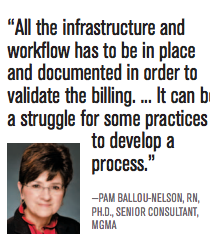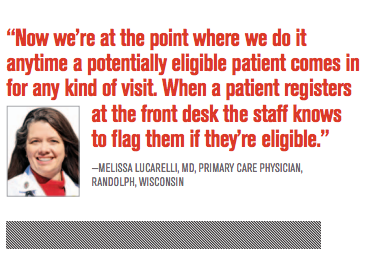Article
Make CCM work for your practice
Author(s):
With the right preparation, chronic care management can create additional revenue
As a solo primary care doctor, Melissa Lucarelli, MD, rarely turns down an opportunity to increase her practice’s revenue. But that’s what she did when, in 2015, Medicare introduced its new billing code for chronic care management (CCM).
She certainly welcomed the code’s purpose: reimbursing providers for the time spent managing the care of patients with multiple chronic conditions. But the restrictions attached to use of CPT code 99490-such as obtaining a patient’s written consent to participate, tracking the time spent on each patient and requiring an $8 monthly patient copay-led Lucarelli to conclude that it wasn’t worth the time and effort for a small independent practice such as hers.
HOT TOPIC: Why your practice should look beyond the 401(k)
“It seemed like a cruel joke,” Lucarelli, a Medical Economics editorial adviser, recalls thinking at the time. “It’s like they were saying, ‘we have this money available but you’re never going to be able to get it.’”
But Medicare subsequently eased some CCM billing requirements-for example, allowing providers to obtain verbal rather than written consent from patients before providing services billed to the code. And it raised the reimbursement amount for the original code and added new ones with the potential for practices to earn even more from providing the services.

Those changes led Lucarelli, at the suggestion of a staff member, to look again at whether billing CCM could be cost-effective. She decided to give it a try.
MORE: Top 10 cities for physician demand
The results so far have exceeded Lucarelli’s expectations. After less than a year her practice, based in the rural town of Randolph, Wisconsin, is earning about $4,600 per month from providing chronic care management services to 113 Medicare patients. The additional income has enabled her to hire a part-time care manager and to purchase some new equipment and furnishings for the practice.
Next: The growth of CCM
CCM use growing
Lucarelli’s change of heart about billing for chronic care management is part of a growing movement among healthcare providers. According to the Centers for Medicare & Medicaid Services (CMS), the number of billings under the code nearly doubled between the start of 2015 and September, 2017, from just over one million to two million. Over the same period, Medicare payments for CCM grew from $32.4 million to slightly more than $59 million, or about 82%.
But experts caution that using CCM codes involves a great deal more than just billing for services physicians are already providing. Despite the eased requirements, developing a strategy for billing CCM-from deciding which patients are eligible to developing care plans to tracking the time spent on their care-often is difficult and time-consuming.
TRENDING: The paradox in American healthcare
“All the infrastructure and workflow has to be in place and documented in order to validate the billing, and in order for the patient to understand what they are getting,” says Pam Ballou-Nelson, RN, Ph.D., a senior consultant with the Medical Group Management Association (MGMA). “It can be a struggle for some practices to develop a process.”
Reining in costs
Medicare’s focus on patients with multiple chronic conditions reflects a growing concern over how much the agency-and the country-spend to care for these patients, experts say. According to data compiled by the Medicare Learning Network, as of 2014 two-thirds of Medicare beneficiaries had two or more chronic conditions.

Virtually all (99%) of the agency’s $597 billion in benefits payments that year were to treat patients with chronic conditions. Moreover, 84% of all healthcare spending in the country was for patients with chronic conditions.
Reducing that spending by keeping patients out of expensive inpatient settings and emergency departments was one of the chief motivations behind development of the CCM codes, Ballou-Nelson explains.
“Research has shown that patients tend to be able to manage one chronic condition, but when they have more than one is when we start to see complications occur that often require an inpatient admission,” she says.
POPULAR ONLINE: 2018 Payment outlook
Lucarelli uses similar logic when explaining the program to her patients. She presents CCM as a way for Medicare to reduce spending by paying doctors to monitor patients with multiple chronic conditions, enabling them to address problems before they get to the point where the patient requires hospitalization.
Next: Getting started
Start slowly
Lucarelli built her CCM patient base gradually, beginning just with beneficiaries coming in for their Medicare Annual Wellness Visits. Then she expanded it to those coming in for physicals and other forms of routine medical evaluations.
“Now we’re at the point where we do it anytime a potentially eligible patient comes in for any kind of visit,” she says. “When a patient registers at the front desk the staff knows to flag them if they’re eligible and tuck the papers in with the routing slip when the patient gets roomed.”
FURTHER READING: 3 ways PCPs can increase reimbursement with behavioral health partnerships
CCM has brought some unexpected benefits as Lucarelli and her staff gain more experience with the program. For example, the practice’s care coordinator now reviews Lucarelli’s most recent note before calling a patient to check on progress with their care plan. “She’ll say, ‘Mr. Smith, I see that Dr. Lucarelli changed your blood pressure medication. How are you doing with the new one?’ And a couple of times we discovered patients weren’t taking them. So I’d make sure the pharmacy had the medication available and call [the patient] to see what was going on,” Lucarelli explains.
The care coordinator also uses her care plan check-in calls to remind patients to get flu shots and other vaccinations for which they are due. Lucarelli notes that patients in the CCM program are at high risk for contracting the flu simply by being elderly and having at least two chronic conditions.
Partly as a result of these reminders, her practice ran out of flu vaccine in October of last year-earlier than ever before-and had to order more. It also enabled the practice to earn more from administering vaccines than in previous years, she says.
Leisa Bailey, MD, a primary care physician with a practice in the Florida panhandle town of Bonifay, began planning to use the chronic care management code in 2014, when she first learned about it. So by the start of 2015, when the code became effective, she had the patient consent forms and all the other requirements completed.
Like Lucarelli, Bailey took a gradual approach to signing patients up. “Starting in January, as patients came in for physicals and other reasons, if they were appropriate for CCM, I told them about the plan and asked them to sign up. I’d have them fill out a short questionnaire, then over the weekend I’d develop their care plans,” she says.

At that point, Bailey handed off the patient’s care to her practice’s nurse, half of whose time had been allotted to chronic care management. When she had signed up more patients than her nurse could handle part-time, she hired another staff member, an LPN, to take on the responsibility full-time.
“She does nothing but take care of my 200 Medicare patients who have chronic conditions,” Bailey explains. “She follows up on every test they have and every referral, and she’s available any time they have a question. I call her my combination nurse/social worker/counselor, because she does it all.”
IN CASE YOU MISSED IT: 5 ways to increase the value of a medical practice
The LPN also handles wellness visits for these patients. “Pretty soon they come to think of her as ‘their’ nurse, and the patients love it,” Bailey adds. “We get a lot of compliments from patients on how well everyone in the office takes care of them.”
At first, Bailey used the code only when treating severe problems such as chronic obstructive pulmonary disease (COPD) and diabetes. But then she learned that the time she spent treating conditions such as arthritis and depression could also be billed to it. “If a patient has one of the ‘biggies,’ like COPD, they almost always have something like arthritis,” she notes. “So I was able to include more patients when I realized I it included more conditions.”
Bailey estimates using the CCM code has increased her practice’s revenue by about $6,000 per month. “It’s not huge, but it’s enough that even after paying the LPN I have some left over that I can put into new equipment and some trips for CME,” she says.
Next: The importance of care plans
The importance of care plans
Even with billing for CCM on the upswing, however, Ballou-Nelson believes many practices remain hesitant to use the codes because they don’t know how to properly develop and implement patient care plans. To start with, she says, plans often lack input from the patients themselves.
“When I do plan audits, I often see no voice of the patient whatsoever,” she says. “There’s nothing about their goals, about what they think is important. I have to ask the provider, ‘where is the shared decision-making, the self-management piece? What exercises and activities are you giving them?’”
HOT TOPIC: The definitive guide to patient engagement
After the plan is created, Ballou-Nelson says, the next step is to develop templates that can be entered into the practice’s electronic health record (EHR) covering the plan’s goals, such as treating depression or lowering A1C levels. That makes the plan accessible to everyone in the practice who interacts with the patient.
Ballou-Nelson also recommends developing fact sheets and questionnaires related to the care plan that patients can take home and work with. The latter, she says, might ask the patient to list all their medications related to a disease such as diabetes and what the medication does. It could also include questions such as, “How do you feel about having to take insulin and other medications for diabetes?” “What are the hardest parts about taking your medications?”
The goal, she explains, is “to give patients some investment in their care. Then when you make those follow-up calls or they come for a return visit, you can relate back to the activities you’ve given them, and you’ve got topics to discuss.”
MORE: Addressing hypertension cn aid value-based scores
Putting together this kind of care plan can appear overwhelming at first, Ballou-Nelson acknowledges, but adds that it gets easier as it becomes part of a practice’s culture. For some practices, she says, the process has become so ingrained that providers develop care plans for every patient that comes in, regardless of the number or severity of their conditions.
Next: Advice for beginners
Advice for beginners
For practices considering billing for CCM services, current users offer similar advice: plan ahead, start slow and make sure everyone in the practice understands what CCM involves. “Be sure you’ve got people who know what’s required, because there are some weird little hoops you’ve got to jump through to fulfill the [billing] requirements,” Lucarelli says.
As an example, she cites the requirement that patients be offered a copy of their care plan and that the offer is documented in the patient’s record. “You’d hate to put in all the work and then not get paid because you’re missing a piece,” she says.
“Identify someone in your organization who is a people person and has good organizational skills, and give them some dedicated time each day,” Bailey advises. “Then as the program builds, you can look at whether it makes sense to hire someone full-time.”
TRENDING: 4 benefits of Medicare annual wellness visits
Ballou-Nelson also advocates holding off on hiring a full-time care manager, noting that in finding time for a current staff member to take on the responsibilities practices sometimes find they have excess capacity.
“I’m a big proponent of, ‘let’s try to work with the staff we have right now,’” she says. “Let’s see who we can retrain, what we can reorganize and what we can get by with.”
Newsletter
Stay informed and empowered with Medical Economics enewsletter, delivering expert insights, financial strategies, practice management tips and technology trends — tailored for today’s physicians.





